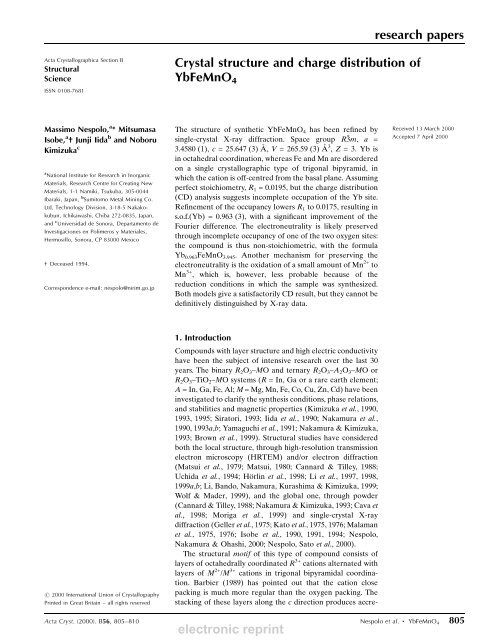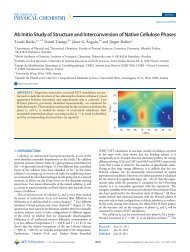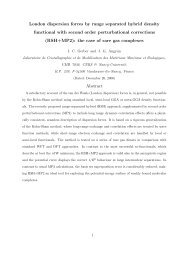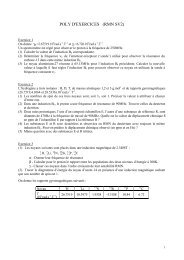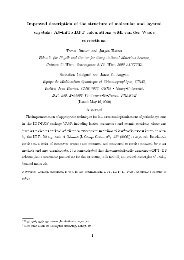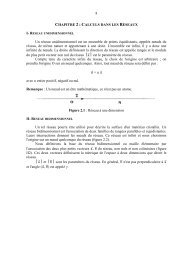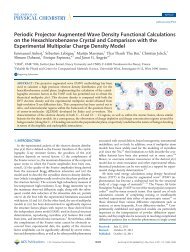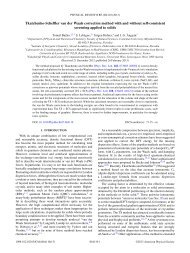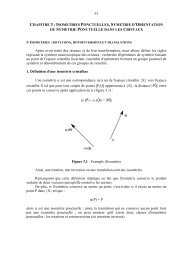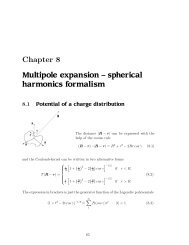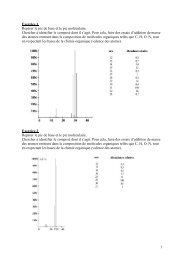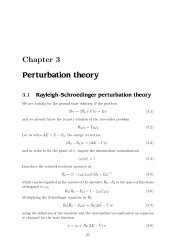esearch papersActa <strong>Crystal</strong>lographica Section BStructuralScienceISSN 0108-7681<strong>Crystal</strong> <strong>structure</strong> <strong>and</strong> <strong>charge</strong> <strong>distribution</strong> <strong>of</strong>YbFeMnO 4Massimo Nespolo, a * MitsumasaIsobe, a ² Junji Iida b <strong>and</strong> NoboruKimizuka ca National Institute for Research in InorganicMaterials, Research Centre for Creating NewMaterials, 1-1 Namiki, Tsukuba, 305-0044Ibaraki, Japan, b Sumitomo Metal Mining Co.Ltd, Technology Division, 3-18-5 Nakakokubun,Ichikawashi, Chiba 272-0835, Japan,<strong>and</strong> c Universidad de Sonora, Departamento deInvestigaciones en Polimeros y Materiales,Hermosillo, Sonora, CP 83000 Mexico² Deceased 1994.Correspondence e-mail: nespolo@nirim.go.jpThe <strong>structure</strong> <strong>of</strong> synthetic YbFeMnO 4 has been re®ned bysingle-crystal X-ray diffraction. Space group R3Åm, a =3.4580 (1), c = 25.647 (3) A Ê , V = 265.59 (3) A Ê 3 , Z =3.Ybisin octahedral coordination, whereas Fe <strong>and</strong> Mn are disorderedon a single crystallographic type <strong>of</strong> trigonal bipyramid, inwhich the cation is <strong>of</strong>f-centred from the basal plane. Assumingperfect stoichiometry, R 1 = 0.0195, but the <strong>charge</strong> <strong>distribution</strong>(CD) analysis suggests incomplete occupation <strong>of</strong> the Yb site.Re®nement <strong>of</strong> the occupancy lowers R 1 to 0.0175, resulting ins.o.f.(Yb) = 0.963 (3), with a signi®cant improvement <strong>of</strong> theFourier difference. The electroneutrality is likely preservedthrough incomplete occupancy <strong>of</strong> one <strong>of</strong> the two oxygen sites:the compound is thus non-stoichiometric, with the formulaYb 0.963 FeMnO 3.945 . Another mechanism for preserving theelectroneutrality is the oxidation <strong>of</strong> a small amount <strong>of</strong> Mn 2+ toMn 3+ , which is, however, less probable because <strong>of</strong> thereduction conditions in which the sample was synthesized.Both models give a satisfactorily CD result, but they cannot bede®nitively distinguished by X-ray data.Received 13 March 2000Accepted 7 April 2000# 2000 International Union <strong>of</strong> <strong>Crystal</strong>lographyPrinted in Great Britain ± all rights reservedActa Cryst. (2000). B56, 805±810 Nespolo et al. YbFeMnO 4 8051. IntroductionCompounds with layer <strong>structure</strong> <strong>and</strong> high electric conductivityhave been the subject <strong>of</strong> intensive research over the last 30years. The binary R 2 O 3 ±MO <strong>and</strong> ternary R 2 O 3 ±A 2 O 3 ±MO orR 2 O 3 ±TiO 2 ±MO systems (R = In, Ga or a rare earth element;A = In, Ga, Fe, Al; M = Mg, Mn, Fe, Co, Cu, Zn, Cd) have beeninvestigated to clarify the synthesis conditions, phase relations,<strong>and</strong> stabilities <strong>and</strong> magnetic properties (Kimizuka et al., 1990,1993, 1995; Siratori, 1993; Iida et al., 1990; Nakamura et al.,1990, 1993a,b; Yamaguchi et al., 1991; Nakamura & Kimizuka,1993; Brown et al., 1999). Structural studies have consideredboth the local <strong>structure</strong>, through high-resolution transmissionelectron microscopy (HRTEM) <strong>and</strong>/or electron diffraction(Matsui et al., 1979; Matsui, 1980; Cannard & Tilley, 1988;Uchida et al., 1994; HoÈ rlin et al., 1998; Li et al., 1997, 1998,1999a,b; Li, B<strong>and</strong>o, Nakamura, Kurashima & Kimizuka, 1999;Wolf & Mader, 1999), <strong>and</strong> the global one, through powder(Cannard & Tilley, 1988; Nakamura & Kimizuka, 1993; Cava etal., 1998; Moriga et al., 1999) <strong>and</strong> single-crystal X-raydiffraction (Geller et al., 1975; Kato et al., 1975, 1976; Malamanet al., 1975, 1976; Isobe et al., 1990, 1991, 1994; Nespolo,Nakamura & Ohashi, 2000; Nespolo, Sato et al., 2000).The structural motif <strong>of</strong> this type <strong>of</strong> compound consists <strong>of</strong>layers <strong>of</strong> octahedrally coordinated R 3+ cations alternated withlayers <strong>of</strong> M 2+ /M 3+ cations in trigonal bipyramidal coordination.Barbier (1989) has pointed out that the cation closepacking is much more regular than the oxygen packing. Thestacking <strong>of</strong> these layers along the c direction produces accre<strong>electronic</strong><strong>reprint</strong>
esearch papersTable 1Experimental details for YbFeMnO 4 .<strong>Crystal</strong> dataCell settingHexagonalSpace groupR3 ma (A Ê ) 3.4580 (1)c (A Ê ) 25.647 (3)V (A Ê 3 ) 265.59 (3)Z 3Radiation typeMo KWavelength (A Ê ) 0.71073No. <strong>of</strong> re¯ections for cell parameters 18 range ( ) 40.98±45.30Temperature (K) 293 (2)<strong>Crystal</strong> formSphere<strong>Crystal</strong> radius (mm) 0.055<strong>Crystal</strong> colourBlackData collectionDiffractometerEnraf±Nonius CAD-4Data collection method!± scansAbsorption correctionSphereT min 0.086T max 0.166No. <strong>of</strong> measured re¯ections 655No. <strong>of</strong> independent re¯ections 577No. <strong>of</strong> observed re¯ections 528Criterion for observed re¯ectionsI > 2(I)R int 0.0196 max ( ) 59.84Range <strong>of</strong> h, k, l 0 ! h ! 70 ! k ! 460 ! l ! 61No. <strong>of</strong> st<strong>and</strong>ard re¯ections 3Frequency <strong>of</strong> st<strong>and</strong>ard re¯ectionsEvery 240 minIntensity decay (%) 0.5Re®nementRe®nement on F 2s.o.f. (Yb) = 1 s.o.f. (Yb) = 0.963Chemical formula weight 347.83 341.49D x (Mg m 3 ) 6.524 6.405 (mm 1 ) 33.593 32.637R‰F 2 >2…F 2 †Š 0.0195 0.0175wR…F 2 † 0.0524 0.0437S 1.153 1.184No. <strong>of</strong> re¯ections used 577 577in re®nementNo. <strong>of</strong> parameters used 13 14…=† max 0.000 0.001 max (e A Ê 3 ) 3.39 at 2/3,1/3,0.1059(0.30 A Ê from Fe/Mn)2.55 at 0,0,0.1109(0.44 A Ê from O1) min (e A Ê 3 ) 6.20 at 0,0,0.0214(0.55 A Ê from Yb)4.88 at 0,0,0.0217(0.56 A Ê from Yb)Extinction method SHELXL (Sheldrick,1997)SHELXL (Sheldrick,1997)Extinction coef®cient 0.0237 0.0290 (11)tional homologous series, i.e. series in which the type(s) <strong>and</strong>the general shapes <strong>of</strong> building blocks, as well as the principlesde®ning their mutual relationships, are preserved, but the size<strong>of</strong> these blocks increases with the number <strong>of</strong> coordinationpolyhedra in them (Makovicky, 1997).Ideal trigonal bipyramids, with two identical apical bonds,have been found only in compounds where the bipyramidshost a single type <strong>of</strong> cation, such as InGaO 3 (II) (Shannon &Prewitt, 1968). When different cations enter the bipyramids,these no longer have their two apical bonds identical <strong>and</strong> havebeen classi®ed into two types. Type I has the three basal MÐObonds shorter than the two apical ones: the cation is stillrelatively close to the basal plane, <strong>and</strong> the bipyramid is notmuch distorted. Type II has the cation signi®cantly <strong>of</strong>f-centredfrom the basal plane, towards one <strong>of</strong> the corners: one <strong>of</strong> theapical bonds is shorter <strong>and</strong> the other is longer than the threebasal ones (Nespolo, Sato et al., 2000).The above compounds can be classi®ed into two accretionalhomologous series: (R 3+ M 3+ O 3 ) n M 2+ O, analogous to the(YbFeO 3 ) n FeO series (Kato et al., 1975, 1976; Malaman et al.,1975, 1976; Kimizuka et al., 1976), <strong>and</strong> R 3+ M 3+ O 3 (M 2+ O) m ,analogous to the LuFeO 3 (ZnO) m series (Isobe et al., 1994).The latter has recently drawn attention from differentresearch groups, because <strong>of</strong> the unusual features <strong>of</strong> highermembers. In particular, for R = In or Ga, M 3+ = Fe <strong>and</strong> M 2+ =Zn, extra re¯ections in the selected-area electron diffractionpattern were reported (Li et al., 1997, 1998, 1999a; Li, B<strong>and</strong>o,Nakamura, Kurashima & Kimizuka, 1999) <strong>and</strong> interpreted interms <strong>of</strong> superspace group analysis (Li et al., 1998). TEMobservations have revealed the existence <strong>of</strong> a modulationwave involving the octahedral cation (Li et al., 1997, 1998,1999a; Li, B<strong>and</strong>o, Nakamura, Kurashima & Kimizuka, 1999;HoÈ rlin et al., 1998; Wolf & Mader, 1999), whose origin is atpresent unclear. No modulated <strong>structure</strong> has been reported s<strong>of</strong>ar in members with m < 6. The <strong>structure</strong> <strong>of</strong> this series hasbeen recently rationalized in terms <strong>of</strong>m ˆ 2K ‡ L;…1†where K 0 <strong>and</strong> L =0or1(K <strong>and</strong> L are both integers). Theideal symmetry is P6 3 /mmc <strong>and</strong> R3Åm for L = 0 <strong>and</strong> L =1,respectively. In higher members with a modulated <strong>structure</strong>the symmetry is actually reduced, at least locally, to orthorhombic<strong>and</strong> monoclinic, respectively (Li et al., 1998).Important insights into the structural details <strong>of</strong> thesecompounds can be obtained by the <strong>charge</strong> <strong>distribution</strong> (CD)analysis (Hoppe et al., 1989; Nespolo et al., 1999). The CDmethod is the most recent development <strong>of</strong> the classical theory<strong>of</strong> bond strength (Pauling, 1929) <strong>and</strong> differs from the bondvalence (BV) approach (Brown, 1978) in exploiting the truebond distances in a kind <strong>of</strong> self-consistent computation ratherthan employing empirical curves. Differently from the BVmethod, in the CD approach the computed `<strong>charge</strong>s' (Q) <strong>of</strong>the cations <strong>and</strong> <strong>of</strong> the anions convey different information. Inshort, by labelling q the formal oxidation number, the q/Qratio for the cations indicates the correctness <strong>of</strong> the <strong>structure</strong>determination, whereas the same ratio for the anionsmeasures the degree <strong>of</strong> over- or under-bonding. The analysis<strong>of</strong> the structural details on the basis <strong>of</strong> the strength <strong>of</strong> eachbond (called `bond valence' in the BV<strong>and</strong> `bond weight' in theCD) is meaningful only when the <strong>structure</strong> is correctly re®ned<strong>and</strong> the empirical method itself is applicable. The BV methoddoes not contain any internal criterion for such an evaluation,while the CD method has in the q/Q ratio for the cationsprecisely this kind <strong>of</strong> criterion (for details refer to Nespolo etal., 1999).The CD analysis <strong>of</strong> several compounds belonging to the twoaccretional homologous series described above has revealedthat those containing type II trigonal bipyramids have a q/Q806 Nespolo et al. YbFeMnO 4 Acta Cryst. (2000). B56, 805±810<strong>electronic</strong> <strong>reprint</strong>


